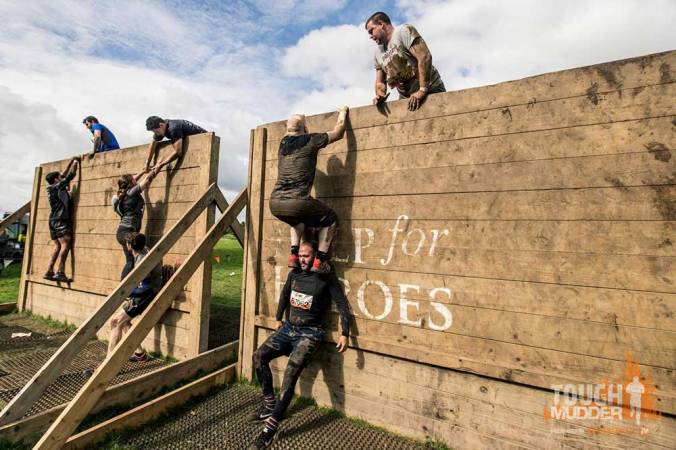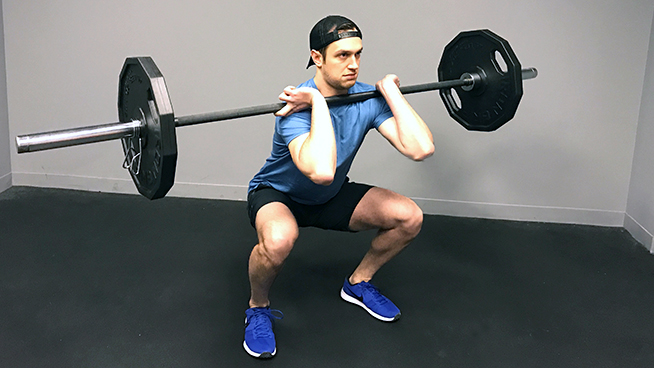I did my first Tough Mudder last year and within an hour of finishing it, I’d booked my second. It’s a tough physical and mental challenge but has incredibly social feel to it from the festival like stalls out front to the team spirit cemented through the race.
But it does require a bit of preparation; you can’t just turn up and ease your way though a half marathon length obstacle course. So over the next 16 weeks I’m going to go through my training for Tough Mudder.
So I keep myself in good general fitness, but 16 weeks out is when I begin to train specifically for the race, preparing specifically for the challenges of the race.
So my workout is split into two strength workouts, two endurance workouts and one long run with my week looking like this:
| Monday |
Tuesday |
Wednesday |
Thursday |
Friday |
Saturday |
Sunday |
| Strength Training |
Endurance Training |
Rest |
Strength Training |
Endurance Training |
Rest |
Long Run |
So let’s look into the strength training:
| Week one |
| Type |
Exercise |
Reps |
Sets |
Weight |
rest time |
| Primary |
Front Squat |
5/4/3/3/3 |
2 warm ups / 3 working |
65/70/80% of 1 Rep max |
1 minute 30 -2 minutes |
| Primary |
Pull ups |
5/4/3/3/3 |
2 warm ups / 3 working |
65/70/80% of 1 Rep max (including body weight) |
1 minute 30 -2 minutes |
| Primary |
Shoulder Press |
5/4/3/3/3 |
2 warm ups / 3 working |
65/70/80% of 1 Rep max |
1 minute 30 -2 minutes |
|
|
|
|
|
|
| Accessory |
DB Bench Press |
10 |
3 working |
70% of 1 Rep max |
30 seconds – 1 minute |
| Accessory |
Back Row |
10 |
3 working |
70% of 1 Rep max |
30 seconds – 1 minute |
| Accessory |
Knee Raises |
16 |
3 working |
70% of 1 Rep max |
30 seconds – 1 minute |
| Week Two |
| Type |
Exercise |
Reps |
Sets |
Weight |
rest time |
| Primary |
Front Squat |
4/3/3/3/3 |
1 warm ups / 4 working |
72.5/82.5% of 1 Rep max |
1 minute 30 -2 minutes |
| Primary |
Pull ups |
4/3/3/3/3 |
1 warm ups / 4 working |
72.5/82.5% of 1 Rep max (including body weight) |
1 minute 30 -2 minutes |
| Primary |
Shoulder Press |
4/3/3/3/3 |
1 warm ups / 4 working |
72.5/82.5% of 1 Rep max |
1 minute 30 -2 minutes |
|
|
|
|
|
|
| Accessory |
DB Bench Press |
10 |
4 working |
70% of 1 Rep max |
30 seconds – 1 minute |
| Accessory |
Back Row |
10 |
4 working |
70% of 1 Rep max |
30 seconds – 1 minute |
| Accessory |
Knee Raises |
18 |
4 working |
70% of 1 Rep max |
30 seconds – 1 minute |
So the workout is split into 3 primary movements and 3 accessory movements, the Primary movements are exercises that relate directly to the obstacles that you would face. I’ll go into my choices in more detail in later articles.
Accessory exercises help balance out the workout, and provide extra training to muscle groups that would support your primary movements.
As a rule, I always do 5 sets of a primary exercise and at this point you should always feel like you should be able to do 1 to 2 more reps at the end of a set. This will change as we go though the season, working towards peak strength.
Endurance wise the workout look like this:
| Muscle Endurance |
|
Week 1 |
Week 2 |
|
Weight target |
Circuits |
Duration |
Circuits |
Duration |
| Sprints |
+5KM Pace |
3 |
4 mins |
3 |
4 mins |
| Band High rows |
30% 1RM |
4 mins |
4 mins |
| Press ups / Half Press ups |
BW |
4 mins |
4 mins |
| Sprint |
+5KM pace |
4 mins |
4 mins |
| Band High rows |
30% 1RM |
4 mins |
4 mins |
| alternating DB Lunges |
BW |
4 mins |
4 mins |
| Rest |
|
2 mins |
2 mins |
|
Total Session Time |
76 |
76 |
So the point of this phase is to build up your muscles ability to withstand lactic acid, or simply how long your muscles can last before they start to burn. Again exercises are chosen to be specific to the challenges provided by the course and split into Primary and accessory moves. The key here is light and lots of repetitions.
The big Primary move here is the short sprints between movements, as this is the closest match to Tough Mudder. The biggest misconception is that Tough Mudder is similar to a straight half marathon, leaving people to overly focus on distance running. In truth it’s a series of medium distance running bursts punctuated with obstacles and rest stops, giving you time to recover. So if you train to withstand fast, quick bursts with active recovery you’ll fair much better.
These workouts are long, but if you want to modify them for an hour’s workout you can set it up like this:
| Muscle Endurance |
|
Week 1 |
Week 2 |
|
Weight target |
Circuits |
duration |
Circuits |
duration |
| Sprint |
5KM Pace |
3 |
2 mins 30 |
3 |
2 mins 30 |
| Band High rows |
30% 1RM |
2 mins 30 |
2 mins 30 |
| Press ups / Half Press ups |
BW |
2 mins 30 |
2 mins 30 |
| Sprint |
5KM pace |
2 mins 30 |
2 mins 30 |
| Band High rows |
30% 1RM |
2 mins 30 |
2 mins 30 |
| alternating DB Lunges |
BW |
2 mins 30 |
2 mins 30 |
| Rest |
|
2 mins |
2 mins |
|
Total Session Time |
49 |
49 |
You’ll still develop muscle endurance, though obviously not as much as someone who has trained for longer time frames.
And then to the long run.
You still need some long distance capacity, so over the course of the next 16 weeks we’ll also add a slow along run. Starting at shorter distances and building up towards 2 hour runs.
Week 1 and 2 look like:
| Week 1 |
Week 2 |
| 25 minute run |
35 minute run |
And that is your basic tool kit for your first two weeks of Tough Mudder training; I’ll get into the specifics as we go along this series, as well as modifications to the workouts to improve your abilities.
Good luck, and most importantly, have fun.






You must be logged in to post a comment.